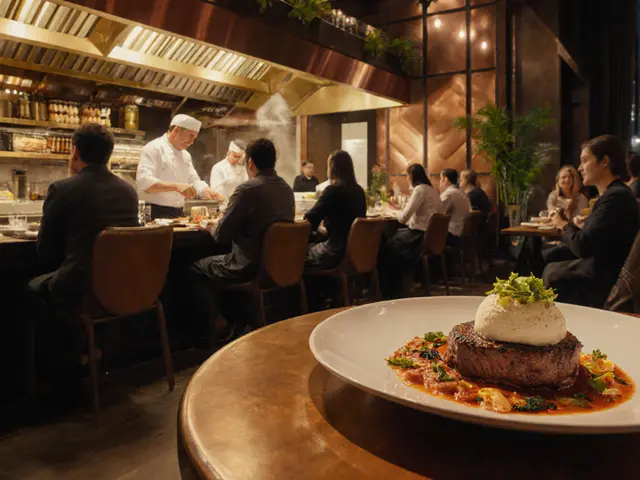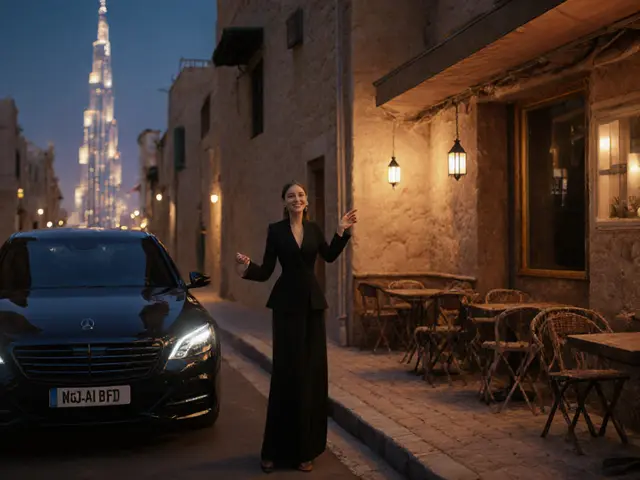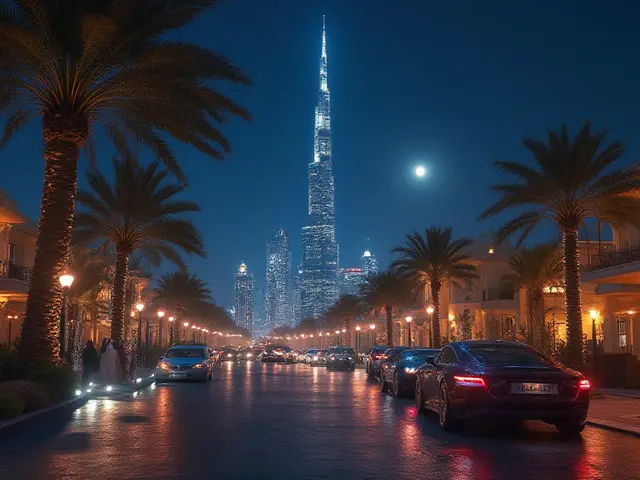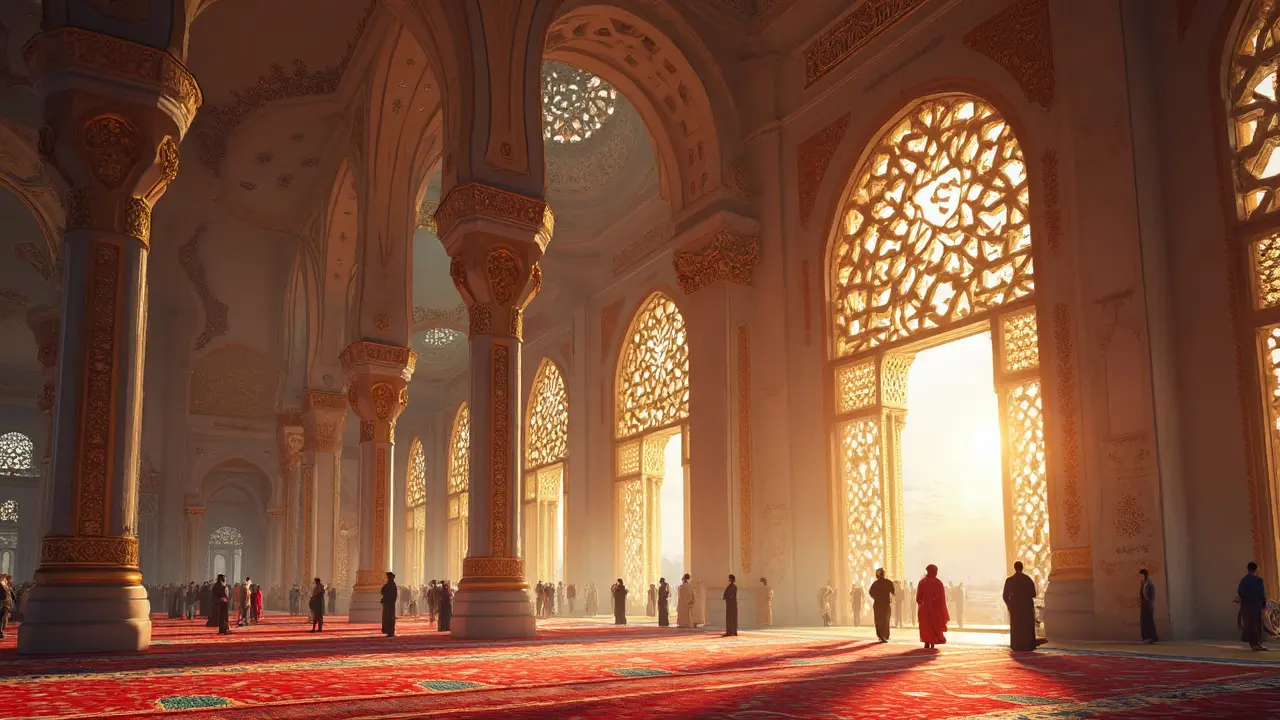
If you live in Dubai, you’ve probably seen Jumeirah Mosque’s creamy minarets rising above Jumeirah Beach Road. But stepping inside is a totally different experience. This isn’t just another photo stop along the city’s coastline. Walking through those doors, you get why so many people call this the most beautiful mosque interior open to non-Muslims in the UAE.
The welcome here is real. Guided tours run almost every day, led by staff from the “Open Doors. Open Minds.” initiative. It’s popular, but never feels rushed or crowded. You’re encouraged to look up, look down, ask questions—nothing is off-limits if you’re genuinely curious. The marble beneath your feet is cool even when it’s scorching outside, and there’s no distracting noise. Jumeirah Mosque’s inside is like a reset for the senses.
Timing matters. Tours usually start at 10am sharp, and you’ll want to arrive early—traffic along Jumeirah Beach Road is no joke during peak hours. Dress code is simple and straight to the point: long loose clothing and a scarf for women (they provide abayas and scarves at the entrance for free if you don’t have your own). No need to stress if you’re coming straight from work or the gym; they’ve seen it all, and the staff are friendly about helping you fit in.
- Stepping Inside: First Impressions
- Architectural Highlights to Look For
- Patterns, Colors, and Symbolism
- Etiquette and Visiting Tips
- Cultural Events and Tours
- Local Connections: Where to Go Next
Stepping Inside: First Impressions
The first thing you notice inside Jumeirah Mosque is just how bright and open everything feels. Dubai’s light pours in through stained-glass windows, bouncing off the pale marble walls. This isn’t a crowded or cluttered place. The massive prayer hall is calm, almost echoey, letting you take it all in at your own pace.
The main dome sits like a centerpiece right above your head—a true landmark of Islamic architecture. You’ll spot hand-carved Arabic calligraphy circling the cornices, with passages taken from the Quran. The writing isn’t just for show; ask any tour guide and they’ll tell you which surahs you’re looking at, and what they mean in daily life for Muslims in Dubai.
Most people are struck by how different the Jumeirah Mosque feels compared to mosques in other parts of the world. There’s a strong Fatimid influence here, which gives the interior a North African twist—look for the horseshoe-shaped arches and ornate plasterwork. The mosque is kept spotless, even with hundreds of guests daily, thanks to a team that works round-the-clock. No food or drinks inside; that’s one rule they stand by to keep the floors and carpets in perfect shape.
Get ready to take your shoes off at the main entrance. There’s a large shelf specifically for footwear, and staff are always around to help if you’re not sure what to do. This isn’t just tradition; it’s about keeping the prayer space clean and comfortable for everyone.
If you’re into photography, visitors are welcome to take pictures of the architecture (just not people praying). The first few minutes are usually a blur of snapping photos and subtle nods from staff, who are used to seeing wowed faces as the doors open. Even if you’ve walked past Jumeirah Mosque hundreds of times, nothing beats the first look from inside.
Architectural Highlights to Look For
When you walk into Jumeirah Mosque, you’ll notice the architecture is impressive but not intimidating. The design sticks close to classic Fatimid style, which you’ll see in the domes, columns, and pointed arches. This style actually comes from Egypt and North Africa, so it’s not something you’ll find everywhere in the Gulf. Mind the symmetry—everything from the windows to the prayer niches (mihrabs) is laid out with neat lines and order.
Start by looking up. The main dome is the real star here, right above the prayer hall. It’s decorated with delicate Qur’anic calligraphy, geometric shapes, and soft blue and gold accents. The way the sunlight comes through the high windows in the dome makes the inside feel calm even if the city outside is buzzing. Notice the two minarets as you step outside; they’re bigger than you think up close and offer a different view at sunset, when the whole mosque almost glows.
Now, keep an eye on the columns. These aren’t just for show. The carved marble pillars are thick and sturdy, but every column cap is unique, covered with patterns that tell their own story—local guides love to share fun facts about the carvings if you ask them. Down at the floor level, the carpets feel cushy under your feet, and the patterns help worshippers form neat rows for prayer.
If you lean in for a closer look at the windows, you’ll spot traditional mashrabiya screens—these lattice-style wooden panels let air in but keep the harsh Dubai sunlight out. The “Open Doors. Open Minds.” tours will usually point out the chandeliers, too. They’re modern crystal but designed to match the mosque’s old-school vibe.
- Look for the Arabic inscriptions above the doors and arches—these are often verses from the Quran and explain the Jumeirah Mosque’s role as both a holy place and a spot for community.
- The mihrab, a small arch set into the front wall, shows the direction of Mecca for prayers and is decorated with subtle tiles—watch for the way the colors shift as daylight moves during the day.
- Notice the marble floors. They’re chilled on purpose (thanks to underfloor cooling) which is a big deal given Dubai’s heat, making visits much more comfortable for everyone.
If you love details, snap a close-up picture of the brass door handles—the intricate floral design is inspired by the palm trees you’ll see all over the UAE, so even the little things connect back to local culture.
Patterns, Colors, and Symbolism
The patterns inside Jumeirah Mosque aren’t just there to look pretty—they actually tell you a lot about Islamic art and Dubai’s unique style. Most designs avoid faces and animals. Instead, you’ll see loads of geometric shapes, floral patterns, and Arabic calligraphy. These aren’t random doodles. In fact, traditional Islamic designs are meant to represent the infinite nature of creation, a sort of visual reminder that there’s order and unity in the world.
Domes and arches tend to grab your attention first. Look up at the central dome and you’ll spot layers of delicate Arabic script from the Quran. The blue and turquoise tiles trace the outer rim of the dome and are meant to evoke calmness and spiritual focus. Gold is used sparingly, but when you see it, it signals something important—often highlighting sections of calligraphy or framing prayer niches, known as mihrabs.
If you glance at the prayer carpets, you’ll see subtle lines woven into the patterns. These lines serve a practical purpose: to help worshippers line up neatly during prayers. The carpets are mostly red with small gold and blue details, matching the main color palette of the mosque. No two corners feel ignored—every beam and pillar has tiny, repeating motifs that might remind you of mashrabiya wooden screens you’ve seen elsewhere in Dubai.
The Sheikh Mohammed Centre for Cultural Understanding explains: “Islamic art uses repetition and symmetry, creating a sense of harmony that reflects the principles of our faith and culture.”
Each color choice is intentional. White and cream dominate, creating a cool, open feel (which is necessary given Dubai’s warm climate), and blue hints at water, which holds big meaning in Islamic cultures—think purity and life. Gold pops up to mark special sections, and olive green occasionally appears, echoing the gardens outside.
| Element | Color | Symbolic Meaning |
|---|---|---|
| Dome tiles | Blue/turquoise | Calm, spiritual focus |
| Carpet | Red with gold and blue | Community, order, warmth |
| Walls & pillars | Cream/white | Purity, openness |
| Accent lines & niches | Gold, green | Importance, paradise |
Want a tip? Pay close attention to the calligraphy bands around the arches—they often contain verses you won’t find in other mosques in Dubai, selected to welcome all visitors. Even if you can’t read Arabic, the flow and balance of the script is part of what makes the Jumeirah Mosque interior so memorable.
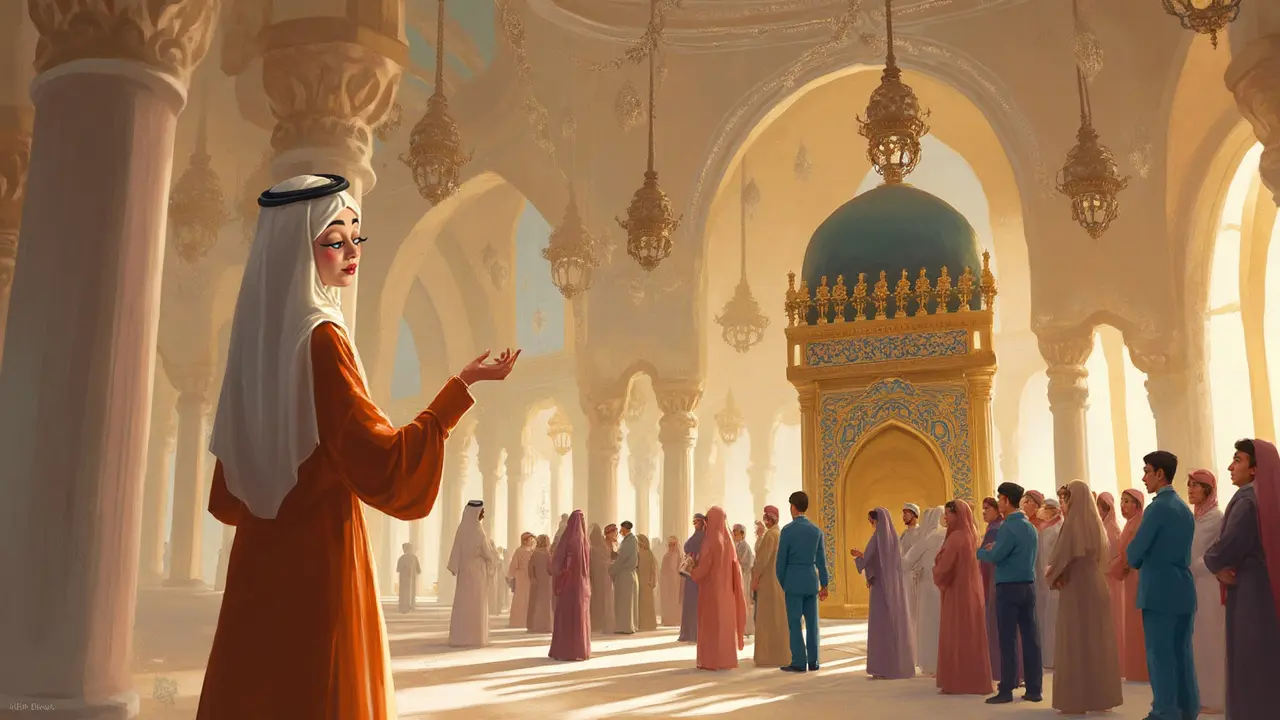
Etiquette and Visiting Tips
Visiting Jumeirah Mosque means following some simple but important customs. The goal isn’t to make you nervous—it’s just about respect. If you’re not sure about something, just ask one of the guides; they’re there to help, not catch you out. Here’s what to know before walking inside the Jumeirah Mosque.
- Dress code: Men should wear trousers and a shirt with sleeves. Women need to cover arms, legs, and hair. Forgot to bring a scarf or abaya? The mosque will lend you what you need right at the door. No flip-flops or flashy prints—think simple and covered.
- Shoes off: You’ll be asked to remove your shoes before stepping on the mosque’s carpets. There are shelves for your footwear, and it’s safe to leave them there.
- Phones: Silence your phone or keep it on vibrate. Snapping a quick photo is usually fine (just avoid taking pictures of other visitors without their okay).
- No food or drink: Leave the Camel Milk ice cream for after your visit; eating and drinking isn’t allowed inside.
- Behavior: Keep your voice low, and avoid public displays of affection—this isn’t the place for holding hands or hugging. If you’re unsure, err on the side of quiet and calm.
For a smooth experience, here’s a quick rundown of the usual schedule and what’s included:
| Tour Days | Tour Start Time | Languages Offered | Duration |
|---|---|---|---|
| Saturday to Thursday | 10:00 AM | English, Arabic | Approx. 75 minutes |
Try to show up at least 15 minutes early on busy weekends. Ramadan hours can change, so check the Sheikh Mohammed Centre for Cultural Understanding’s website or call their info line before turning up. Bringing children? They’re absolutely welcome, just keep them close since this is a peaceful spot.
You don’t need to book a slot in advance for regular tours, but if you’re coming with a group (think school field trip or company offsite), it’s smart to call ahead. Parking can fill up fast during big Dubai events or holidays, so consider using Careem or RTA taxis—the drop-off is right in front, and it saves you a parking headache.
Cultural Events and Tours
If you want more than just a quick visit, Jumeirah Mosque runs one of the city’s most popular guided tours for cultural exchange. The “Open Doors. Open Minds.” program happens almost every day except Fridays, starting at 10am with no need for bookings—just show up a bit early to get a spot. The staff encourage everyone to ask about Islam, Emirati culture, or customs. The goal is to break down walls, and people always come with tons of questions.
Tours last about 75 minutes and are run in English by Emirati or long-term resident guides. If you’re a Dubai resident, you’ve probably already heard about the Arabic coffee and fresh dates they serve at the beginning – it’s a simple, classic welcome that’s part of local hospitality. There’s a short presentation, a quick walk around the mosque, and plenty of time for Q&A at the end. Photography is allowed, so bring your camera or phone.
For bigger groups or schools, they’ll organize private tours on request. The mosque also hosts cultural workshops and Ramadan evening Iftar events, which give an inside look at UAE traditions during the holy month. Don’t be surprised if you spot student groups or international visitors chatting with guides outside—the mosque is a favourite for corporate team building and school field trips.
- Daily guided tours at 10:00am (except Fridays)
- No reservation required—just show up early
- Arabic coffee and dates on arrival
- Q&A session at every tour
- Workshops and Ramadan Iftars held seasonally
Here’s a quick look at recent attendance stats for the tours:
| Month | Average Daily Visitors |
|---|---|
| January | 120 |
| April | 95 |
| August | 80 |
| November | 130 |
The best part? These tours aren’t just info dumps—they’re designed so you can actually connect with the Jumeirah Mosque community and leave knowing something new. Whether you’re a long-time expat or just landed at Dubai International last week, there’s always something fresh to take away from the experience.
Local Connections: Where to Go Next
After checking out the Jumeirah Mosque, you’re in the middle of one of Dubai’s most interesting neighborhoods. Seriously, you don’t have to drive far for your next adventure. Here’s what’s close by and why it’s worth a stop:
- Etihad Museum: Just a 10-minute drive away, this museum is all about the story of the UAE. You get to see original documents, photos, and the actual signing room where the union happened. If you like knowing how Dubai became a global city, this is your spot.
- La Mer Beach: A super popular stretch for chilling by the sea, quick bites, or just grabbing a coffee with the sand between your toes. It’s family-friendly, not far from the mosque, and there are plenty of places to park both your car and your worries.
- Jumeirah Fishing Harbour: This is one of those underrated gems—a real working harbor where you can see the fishing boats come and go, pick up super-fresh seafood, or just snap photos at sunset.
- Mercato Shopping Mall: If the heat’s too much, duck five minutes up the road and you’ll find this Italian-style mall. Not huge, but great for ATM runs, essentials, and casual shopping.
Love food? You’re in luck. Jumeirah Beach Road is Dubai’s “food street” with everything from humble cafeterias to swanky steakhouses. Some locals swear by the shawarma at Automatic Grill, while expats love the brunches at Lime Tree Café.
| Place | Distance from Mosque | Time by Car | Highlights |
|---|---|---|---|
| Etihad Museum | 2.5 km | 10 mins | UAE history, original documents |
| La Mer Beach | 2 km | 7 mins | Beachfront, cafes, family spots |
| Jumeirah Fishing Harbour | 1.8 km | 5 mins | Fresh seafood, local life |
| Mercato Shopping Mall | 1.5 km | 4 mins | Shopping, cool indoors |
Events change with the season. Around Ramadan, watch for the mosque’s own iftar tents and special community talks. La Mer and Mercato Mall also run loyalty promos and food festivals—follow their socials for the latest. If you're hungry for more history, the Dubai Museum at Al Fahidi is a short taxi hop and shows what the city was like long before all the skyscrapers.
Getting around is easy. RTA buses stop right outside the mosque, and Careem or Uber can zap you pretty much anywhere in Jumeirah or downtown Dubai in under 20 minutes, depending on traffic. Rather walk? Stick to the shaded pavements along Beach Road in the early morning or after sundown.
